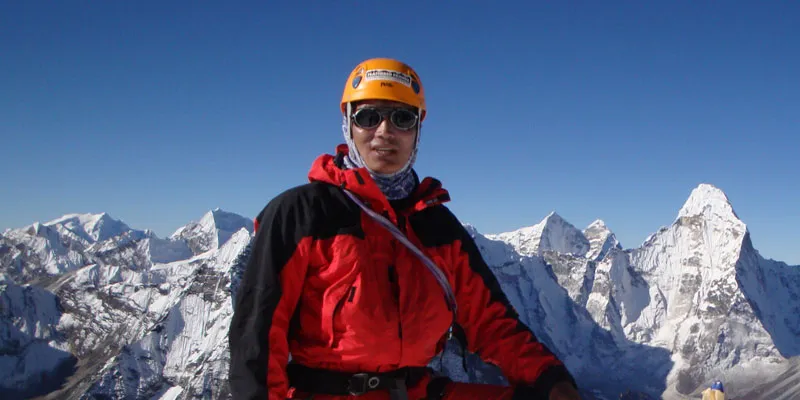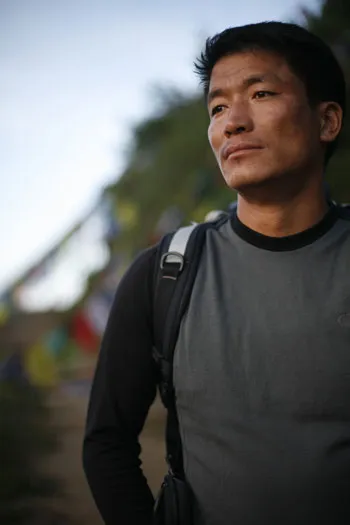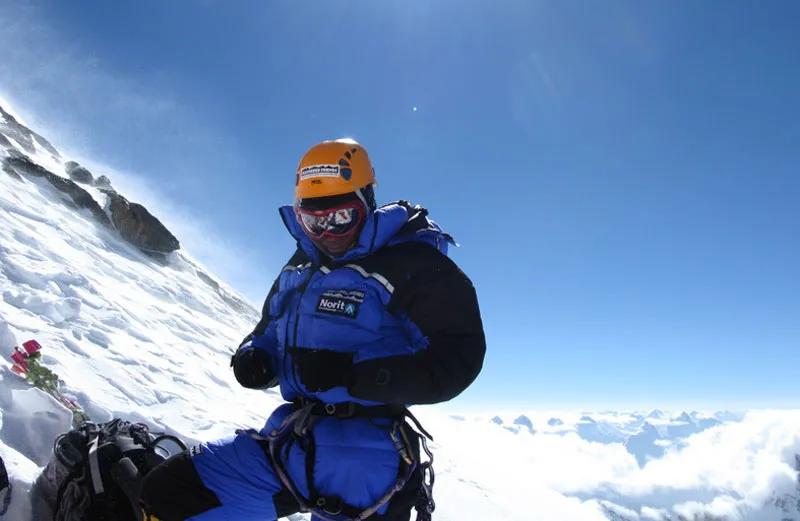Pemba Gyalje Sherpa - A story of heroism and survival on K2 the Savage Mountain

It took 48 hours for nature to create one of the most chilling tales of tragedy, triumph and heroism in mountaineering history. August 1st 2008, over 8000 metres on the second highest peak in the world, K2, and the sun was setting along the curvature of the earth. The survivors say, it was the perfect day for a summit bid.
The 18 climbers from different international climbing expeditions felt their euphoria of a successful summit ebbing away. There were climbers stranded on the most dangerous place on the earth – the descent from the summit of a mountain peak over 8000 metres.
The vast abyss of the ‘Death Zone’ (altitude at which no human body can acclimatize), was yet to be covered and night was claiming the expanse of the sky. The fixed line, their hope and lifeline that would take them safely through the treacherous bottleneck and serac was cleaved off by an avalanche, taking the Norwegian explorer Rolf Bae with it. Eleven of the 18 climbers died on descent.
It has been close to a decade and yet the K2 2008 tragedy brings in strong reactions from the climbing and mountaineering fraternities. However, what exactly happened on that mountain on that ‘perfect day, with perfect conditions’ still remains a source of speculation and controversy. While many perished on that mountain and many came back with miraculous stories of survival, a hero emerged – Pemba Gyalje Sherpa.
In the lap of the Himalayas

Born in a village at an elevation of 3000 metres in a village called Pangkhoma located 50 km south of Mount Everest in Eastern Nepal, Pemba has always been close to the mountains. “I began climbing when I was 16 years old, I would trek and climb around the mountains and forests near Kathmandu,” he says. Apart from working in the profession of trekking and climbing, Pemba would help his family in the farm. He says he has led a simple farmer’s life.
Pemba would go trekking and climbing with his father and soon, Pemba found that trekking and climbing was something he liked doing. So he went ahead to become a qualified climber and mountain guide. With time, he began training by climbing different alpine peaks in Nepal and along the mountains of Chamonix France, where he learned more about modern climbing techniques and ethics.
Pemba has climbed the Everest seven times, and among the other summits are the K2 without supplementary oxygen, Cho-Oyo, Ama Dablam and several ‘6000 metre peaks, which I haven’t accounted,’ as Pemba puts it.
Summit and the treacherous descent
Today famous among the climbing fraternity and media as, Tiger of the Death Zone; over the past 20 years, Pemba has served as a high-altitude porter, climbing instructor, expedition leader and a mountain guide.
In that fateful expedition in 2008, when Pemba became a part of the K2 expedition, he went as a mountaineer of the Norit Expedition Team. Things started changing after they reached the summit. On the descent, Pemba, Gerard McDonnell, Wilco Van Rooijen and Marco Confortola found that the fixed line had been severed leaving behind a tattered rope in its place. They were stuck at the bottleneck and in the Death Zone.
While the others decided to bivouac (improvised campsite usually in natural settings, in this case, in snow) till first light, Pemba didn’t want to risk the night at an elevation of 27,000 feet bang in the middle of death zone. He decided to solo the bottleneck alone along the single tattered line, without oxygen, reaching the safety of Camp IV at 1 am.
To the Death Zone and back

The next day opened possibly one of the darkest days in mountaineering history. Climbers were either hit by the serac fall or had stopped on the mountain out of exhaustion or were lost. Most were suffering from altitude sickness, were frost bitten or exhausted, the death zone was taking its toll on many. “With so many people up there I knew I had to go back. I knew they were alive, they were just not in a physical condition to come down that mountain,” says Pemba.
With chaos reigning, Pemba knew he had to act fast, he had heard over radio that the Italian climber Confortola had been spotted midway along the bottleneck. Pemba immediately began soloing in worsening conditions up towards the already unstable bottleneck, “I knew Confortala was alive there was no turning back, I knew I could help,” says Pemba.
“Cas and I left high camp to help Confortola,” adds Pemba. However, the weather conditions had begun taking its toll on Cas. “He wanted to stop because he was getting tired, but, I kept climbing to help Confortola and bring him back to the safety of the high camp,” says Pemba.
He soon reached the Italian climber and found him in bad shape and Confortola was even suffering from severe altitude sickness. Pemba helped revive Confortola with oxygen and helped guide him to the base of the bottleneck. All the while, maintaining radio contact with two Sherpas who were up the bottleneck helping the stranded South-Korean climbers and their Sherpa cousin.
Suddenly, a roar from above brought down another slide of ice and debris. Unfortunately, Pemba couldn’t help the other climbers, as they were taken away by yet another serac fall and he had to turn back.
Also Read:
From Kashmir to Kanyakumari, Gaurav Siddharth rides on his bicycle ‘Bawri’ to find his inner self
Once back in Camp Four, Pemba set out again to search for Wilco around the region. He was presumed dead as he had no water, he was alone in the open in the death zone, but he had survived the night and was traced through a sat phone he had placed to his wife. Rough coordinates in hand, Pemba along with another team member Cas Van De Gevel went in search of Rooijen.
“I had not given up hope, and I knew Wilco was alive. I got further reassurance when a radio call from base camp confirmed that they saw a yellow dot moving on the mountain slope far below high camp. So Cas and I left again, we began our climb down, but Cas was tired and it was dark, he told me he couldn’t move fast. Asking him to maintain a slow and steady pace, I went down as fast as possible and began looking for Wilco,” says Pemba.
Braving the avalance prone terrain in the night, Pemba searched for hours into the night between camps 4 and 3 for Wilco but was unable to trace him. “At a distance of about 200 metres I heard the satellite phone ringing, but I couldn’t locate him,” says Pemba. At about 2 am Pemba came back to Camp 3 and sheer exhaustion took over.
“Sometime very early in the morning I was woken up by the sound of a falling rock near my tent, I realised the rock accidently fell as Cas was climbing down towards Camp II. When Cas got back to the tent we hydrated ourselves with water and recuperated ourselves. At the same time I got a radio call from base camp, they told me that the yellow dot was about 200 metres from our tent,” says Pemba.
Wasting no time Pemba and Cas set out on the journey again and kept looking for Wilco. “We finally found him,” adds Pemba. Pemba and Cas brought down the frost bitten and completely exhausted Rooijen to camp II.
Though completely exhausted, Pemba staggered back to Camp III along with Wilco, effectively saving the lives of two climbers, “We gave him oxygen, revived him, rehydrated him and then we helped him down to base camp,” says Pemba. It has been years after the tragedy, Pemba has returned to trekking and climbing. “I was lucky on K2. I happened to be physically and mentally fit and thus I could help people,” says a modest Pemba.
“I realised that people were just unable to move because they were physically and mentally exhausted. They weren’t in a position to come down, they were struggling for every breath, but they were alive, I was truly lucky that day. The bottleneck and serac was very unstable and kept falling, it was difficult for people to try to traverse that route, luckily I was able to do it and when there were people stuck and alive, I just had to help out,” says Pemba.
Pemba believes that climbing a hard and tough mountain like K2 needs preparation; he believes that there is no room for error on this ‘unforgiving peak.’ He further adds that he knew a lot of things about K2, from legends and history and other tales. “I prepared myself physically and mentally for that climb and just tried to do my best,” says Pemba.
Also Read:
Disability could not deter 28-yr-old Mani Rogers from taking India to the top of the world
Worship the mountains
When asked why he didn’t back down, Pemba says, “I don’t know, I knew that the mountain was treacherous at that time, but I simply couldn’t turn back and I don’t know why.” While the 2008 K2 had affected the lives of all the 25 climbers, it did not stop or keep Pemba away from the mountains.
He was in fact, back to climbing the next season. For Pemba the mountains have always been an integral part of his life. He would hike uphill 300 metres to reach school and it is not just the fact that he was born in the Himalayan region.
“I have always had a special love for peaks. I love nature in its purest and rawest form. Mountains to us are holy. Before every climb I pray to the mountains, it brings good fortune and safe journey on the mountains,” says Pemba.
Pemba is not just a climbing instructor and mountaineer, for him the mountains mean so much more. Climbing for over 20 years now, Pemba still believes that the mountains teach him something different and new every time. “I am still a student of the mountains,” says Pemba. He says that facing the most unique situations and conditions on the mountains every time is a learning experience. “Even if I climb the same route multiple times, there are new challenges, new lessons and new beauty,” reminisces Pemba.
Further talking about his love for the mountains, Pemba says that you need to trust the mountains and nature. He says understand nature, your own physical and mental condition --. H people, nowadays, just want to get on the top of a summit and they are not focussed on the things that they need to focus on – like good training of the body and mind.
Talking about the changing scenario Pemba says, “Today, high altitude climbs have become very commercial, while this is good for my people and good for local business, many important factors are missed. The most important being safety, if you want to go on a high altitude climb, you need to be completely prepared for it. People with zero experience want to climb mountains, it is very dangerous.”
Officially recognised as an International Mountain Guide by the UIAGM in 2009, Pemba has been working towards the promotion and development of a healthy climbing and mountaineering activities in the Himalayas. Having climbed several different peaks, Pemba has seen a change in scenario in the world of the Himalayas.
One advice Pemba would like to give all mountain climbers is, “With good preparation, training and with an understanding of your body and mind, climbing is possibly one of the best things you can do.”







